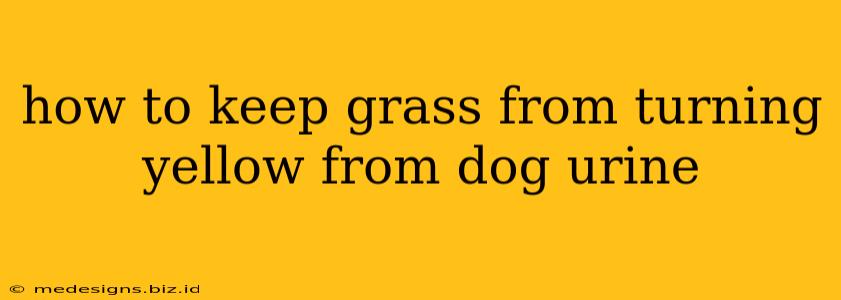Dog owners know the frustration: those unsightly brown or yellow patches in the lawn, the unfortunate result of canine urination. But don't despair! There are effective ways to protect your grass from the damaging effects of dog urine, preserving your lawn's lush green appearance. This guide will equip you with the knowledge and strategies to keep your grass healthy and vibrant, despite your furry friend's contributions.
Understanding the Problem: Why Does Dog Urine Yellow Grass?
Dog urine contains high levels of nitrogen, a nutrient that, while essential for plant growth, can become toxic in concentrated amounts. The high nitrogen concentration burns the grass blades, leading to those characteristic yellow patches. Smaller dogs, whose urine is more concentrated, often cause more severe damage. The alkalinity of dog urine also plays a role, further stressing the grass.
Factors Affecting Damage:
- Dog's Diet: A diet high in protein can increase nitrogen levels in urine.
- Watering Habits: Insufficient watering prevents dilution of the urine, exacerbating the damage.
- Grass Type: Some grass types are more tolerant to high nitrogen than others.
- Soil Type: Well-drained soil helps dilute the urine, minimizing damage.
Effective Solutions to Prevent Yellow Patches
Here are some practical and proven methods to prevent dog urine from yellowing your grass:
1. Dilute the Urine:
Encourage Frequent Urination: Take your dog for more frequent walks, allowing them to urinate in smaller amounts over a larger area. This dilutes the nitrogen concentration, reducing the damage.
Water the Affected Areas: Immediately after your dog urinates, water the spot thoroughly to dilute the urine and flush away the excess nitrogen. A watering can is ideal for targeted watering.
2. Dietary Adjustments:
Consult Your Veterinarian: Discuss your dog's diet with your vet. They can advise on appropriate food choices that may reduce the nitrogen content of their urine. Specific dog food formulas designed to reduce urine pH may be beneficial.
3. Topical Treatments:
Water-Based Solutions: Many commercial products are available that help neutralize the pH of dog urine and reduce the impact on grass. These are usually water-based solutions that you apply to the affected area.
Home Remedies: Some dog owners report success using home remedies like watering with a diluted solution of white vinegar or baking soda. However, always test a small area first to avoid further damage.
4. Lawn Care Practices:
Choose the Right Grass: Opt for grass types known for their tolerance to high-nitrogen conditions. Your local nursery or gardening center can advise on suitable varieties for your region.
Healthy Soil: Maintain healthy soil through regular fertilization and aeration. Healthy soil is better equipped to absorb and process the nitrogen in dog urine.
Overseeding: If damage is already present, overseeding affected areas with a hardy grass can help restore the lawn's appearance.
Preventative Measures:
- Designated Pee Spots: Train your dog to urinate in a specific area of the yard, such as a gravel patch or an area where grass is less valuable. This concentrates the damage in one location, which is easier to manage.
- Regular Lawn Maintenance: Maintain a healthy, strong lawn through regular mowing, fertilization, and watering. A robust lawn is more resistant to damage from dog urine.
Preventing Yellow Spots: A Holistic Approach
By combining these strategies, you can significantly reduce or even eliminate yellow patches in your lawn. Remember, consistency is key. Implementing these techniques regularly will help protect your grass and keep your lawn looking its best, even with a canine companion. Addressing the problem from multiple angles – dilution, diet, and lawn care – yields the most effective results.
